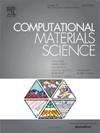Effect of surface polarity on the structure and dynamics of liquids at the alumina solid–liquid interface
IF 3.1
3区 材料科学
Q2 MATERIALS SCIENCE, MULTIDISCIPLINARY
引用次数: 0
Abstract
Molecular dynamics (MD) simulations are used to investigate the structure and dynamics of interfacial water on alumina surfaces as well as mixed liquids confined within alumina pores with varying surface polarities from apolar to polar. Our results demonstrate that the surface polarity has a significant effect on the water layer in the vicinity of the surface, while the internal interactions among water molecules dominate the feature of the water layer far away from the surface. Water molecules on the polar surface occupy all the optimum adsorption sites surrounding the surface oxygen atoms via forming hydrogen bonds, resulting in large residence probability and slow translational mobility as evidenced by free energy estimations. Simulations of liquid ethanol–water mixture within the membrane pore demonstrate that though water molecules are preferentially adsorbed within the pores, the polarization of the alumina pores is in favor of the preferential adsorption of ethanol molecules, thereby compromising the efficiency of ethanol purification. The present results suggest that manipulation of the alumina surface polarity can determine the solid–liquid interactions and the mobile phase transport, and further contribute to improving our knowledge on the basic physical chemistry underlying the electrostatically dominated diffusion behaviors. Our study provides important insight to the polarity modulation of alumina ceramic membranes in future experiments for achieving the designed separation performance in a variety of applications.

求助全文
约1分钟内获得全文
求助全文
来源期刊

Computational Materials Science
工程技术-材料科学:综合
CiteScore
6.50
自引率
6.10%
发文量
665
审稿时长
26 days
期刊介绍:
The goal of Computational Materials Science is to report on results that provide new or unique insights into, or significantly expand our understanding of, the properties of materials or phenomena associated with their design, synthesis, processing, characterization, and utilization. To be relevant to the journal, the results should be applied or applicable to specific material systems that are discussed within the submission.
 求助内容:
求助内容: 应助结果提醒方式:
应助结果提醒方式:


